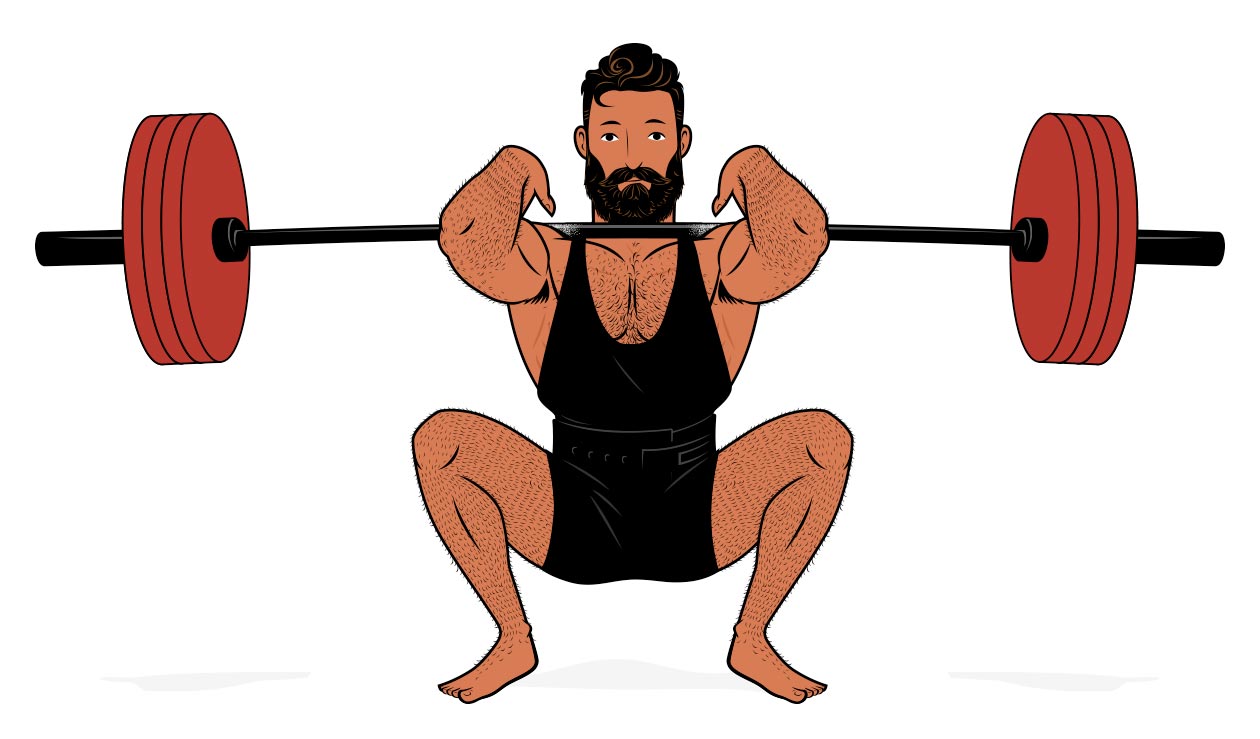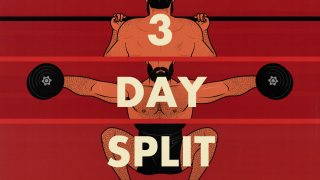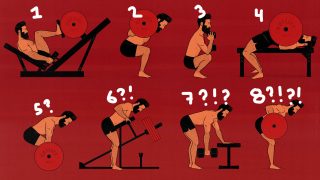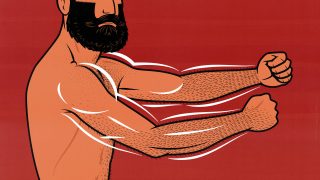
What Happens If You Spread Your Workout Throughout the Day?
What if, instead of doing your workout all at once, you spread your sets or exercises over the day? Maybe that means doing your squats before work, your push-ups before lunch, and your chin-ups before dinner. Or maybe you spread your five sets of chin-ups throughout the day, resting a few hours between each set.
There are many different ways you could split up your workout. How will that affect muscle growth, muscle recovery, fat loss, and your health?

The Health Benefits of Short Bouts of Exercise
There’s a scientific term for doing very small workouts. They’re called “exercise snacks.” It’s a relatively new area of research, and most of it has to do with general health, not muscle growth. For example, this new study from Colombia University found that doing five minutes of exercise every half hour was great for improving blood pressure and mood.
There are a few different studies, all of which show promising results. It seems that breaking up periods of inactivity with short bursts of exercise is amazing for our health (study). It gets our heart rates up and gets blood flowing, giving us a few different benefits:
- Short bouts of stair climbing improve our cardiometabolic health (study, study).
- Short sprints improve cardiovascular fitness (study).
- A quick bit of exercise before meals improves insulin sensitivity and blood sugar regulation (study).
There’s some research looking into short bouts of resistance training, too:
- Doing bodyweight squats every half hour improves muscle-protein synthesis, potentially allowing for greater muscle growth (study).
- Doing a 5-minute bodyweight workout twice per day improves muscle function in older people (study).
- Working up to a quick 1-rep max on one lift improves mood throughout the day (study).
These studies all show favourable results, some of which might theoretically improve our ability to build muscle. None of these studies was specifically trying to stimulate and measure muscle growth, though. So, what happens if we split up a hypertrophy training or strength training workout?
How Splitting Up Your Workout Affects Muscle & Strength
Most people combine their training into a single workout because it’s convenient, not because it’s better. There’s actually no reason to think that training for an hour a few times per week is any better than training for ten minutes a few times per day. If anything, it’s probably slightly better to do shorter workouts more often.
For example, in this study by Hartman and colleagues, splitting a workout in two didn’t harm muscle growth at all. In fact, the participants who did two shorter workouts instead of one longer workout gained more strength. They also had higher testosterone levels and lower cortisol levels. You’d expect this to yield more muscle growth over time. And you’d expect similar benefits if you split up your workout into three, four, or five smaller workouts.
Many professional athletes, powerlifters, and bodybuilders split up their workouts. They prioritize results over convenience, so they often do several short workouts spread out throughout the day instead of one longer workout. When their energy levels start to drop, they stop their workout. They rest. Then they do another workout once they’ve regained their energy.
Splitting up your workouts allows you to recover more fully between each set or between each exercise. You don’t get as tired. Your performance stays higher. That allows you to lift more weight or eke out more repetitions. That extra work is great for gaining muscle and strength.
The Downside of Splitting Up Your Workouts
When I first started experimenting with splitting up my workouts, I was worried it would harm my recovery. What if I do chin-ups in the morning, start recovering, and then interrupt that recovery by doing more chin-ups in the afternoon? Fortunately, that doesn’t seem to be a problem. People who train this way recover just fine—perhaps better (study). After all, it’s very natural to be active at various points throughout the day. Our bodies are built for this.

In fact, we may even be able to improve our recovery by training more often. We build muscle by delivering blood to them. That’s why they get sore and inflamed after working out. We might be able to improve that process by getting our blood flowing, helping to shuttle more nutrients to our muscles. If you’re doing shorter workouts more often, you’ll get your blood flowing more often. In bodybuilding circles, this is called “active recovery,” and it’s thought to be a good thing.
There’s only one downside to splitting up your workouts: convenience. If you can only train at the gym, it can be a slog to trek there several times per day. Even if you’re training at home, it might make your training less efficient. For example, if you’re doing heavy sets of squats several times per day, you might need to do a few mobility drills or warm-up exercises before each of those sets, multiplying the amount of time spent being unproductive.
Mind you, some of these inconveniences are easy to overcome. Nothing’s stopping you from doing a set of push-ups before breakfast, lunch, and dinner. It will be great for building muscle, fantastic for your health, it won’t feel overly tiring, and if anything, you’ll stimulate slightly more muscle growth than if you did all three sets of push-ups in the same workout.
How to Split Up Your Workouts
If you’re doing bodyweight exercises like push-ups and chin-ups, feel free to split your workouts up however you like. I had a friend who built a muscular back by installing a chin-up bar in the doorway leading to his kitchen. He’d do a casual set of chin-ups every time he went in, stopping 1–2 reps shy of failure.
If you train at home, or if getting to the gym is very easy, feel free to split up your workout into a morning and afternoon session. Maybe you do your lower-body exercises before work and your upper-body exercises after work.
If you’re like me and work and lift at home, you could do a set, do some work, and then do another set whenever you feel like it. As long as you make it through your entire workout, you can expect the same results as if you did the entire workout all at once.
If you’re doing bigger exercises like squats, deadlifts, bench presses, or overhead presses, you might be able to get away with doing higher-rep sets without needing any warm-ups. Doing sets of 12–20 reps is just as good for building muscle as doing sets of 5–10 reps. Instead of warming up with a comfortably light set before doing a heavier one, you could just take that lighter set closer to failure, stopping 0–2 reps before your muscles give out.
Summary
Splitting your workout into several smaller ones won’t harm your recovery, muscle growth, or strength gain. If anything, it will slightly improve your results. It’s also great for your health.
The only downside is that it can be less convenient. It can mean more time commuting, setting up, and warming up. If you prefer it, though, then that downside doesn’t matter.
What really matters is that you choose good exercises, do enough sets, and push yourself hard. Also, try to train each muscle 2–4 times per week. The amount of rest you get between sets and exercises matters much less, even if you’re resting for several hours.

Alright, that’s it for now. If you want more muscle-building information, we have a free muscle-building newsletter. If you want a full exercise, diet, and lifestyle program to help you build muscle and improve your cardiovascular health, check out our Bony to Beastly (men’s) program or our Bony to Bombshell (women’s) program. Or, if you’re already an intermediate lifter, check out our customizable Outlift Intermediate Hypertrophy Program.






I generally allow a six hour gap between split days, going heavy in the first workout, then a bit lighter (+boxing work, cardio grinder) in the evenings. Even better is if you can grab a quick nap in between the two sessions. I find any lifting in session #2 is just catch-up lifts, or perhaps a set I left in the tank. I’ve been following the two-a-days every day for about a year with a few recovery half-days once or twice a week.
Although it probably is obvious to readers of this site, it bears reiterating that nutrition and timing is going to play a slightly different role in doing splits.
That’s awesome, man. That sounds like such a cool, effective, and healthy way to train 🙂
This is great input and solidifies my approach due to time.
I do my pushups, squats, abs, stretch in the morning and late afternoon focus on pullups, chinups, and boxing.
3 days per week with some sprints on two alternate days.
That sounds awesome 🙂
Hey guys, would be interested in seeing what you think about greasing the groove, or “farmer’s strength”, keeping volume high, but intensity low. I know it’s good for strength, but not so much for hypertrophy.
I guess it depends on how much you care about efficiency and results.
In my case, when I’m bulking, I put a ton of effort into doing everything properly. I try to optimize as many factors as I can, including making sure the training is challenging enough.
But when I’m doing cardio, I approach it more casually. I get my steps in. I put in the work. I’m not trying to do it optimally, I’m just casually working it into my lifestyle.
You could imagine someone who does it the other way around, doing their lifting more casually and their cardio more seriously. That’s totally fine. It all depends on what you want.
Hey Shane. This is a very interesting concept. I’ve heard of “Greasing the Groove” for bodyweight exercises. I’ve read about the benefits of mini-workouts for mostly sedentary people. However, I haven’t seen too many articles yet about splitting up multiple sets of exercises for hypertrophy. The concept does make intuitive sense to me. Why kill myself packing all exercises into one session when I can focus on one exercise and attack with full focus and energy?
I was wondering how I can apply this concept to my own workouts. I don’t see any issues with spreading out my sets doing a full-body split throughout the day since there is very little overlap between the upper and lower body. Would I run into recovery issues if I run a routine where there is some overlap between body parts like a PPL or Upper/Lower routine?
For example, the Push Day of a PPL routine or the Upper Day of an Upper/Lower routine typically include movements that involve many overlapping muscle groups like the triceps and shoulders. Would I run into potential recovery issues if I, for example, did a horizontal pressing movement, then did a overhead pressing movement a couple of hours later, then finished off the day with some isolation triceps work?
Like you, I can workout whenever I want. Luckily, I work mostly from home and have access to a home gym. Of course, the best way to find out is to try it out for myself. I was just curious to see what your experience has been spreading out traditional splits like the PPL or Upper/Lower splits throughout the day before trying it out for myself.
You should be okay spreading your workouts out throughout the day whether you’re doing full-body workouts or splits. The main thing to watch out for is running into issues related to warming up. If you’re doing low-rep squats or deadlifts, it wouldn’t be wise to sporadically jump right into heavy sets. You might want to warm up properly and do all your sets in one go.
You can run into similar issues with smaller lifts sometimes. For example, in your example of doing your pressing earlier in the day and your triceps extensions at the end, you might want to warm up before those sets of triceps extensions. Get some blood flowing into your elbows before your working sets. Different people are different, but it’s common wisdom to warm up before triceps extensions. I’ve noticed it in my own experiments, too. When I disregard that advice, my elbows complain.
It wouldn’t surprise me if people ran into similar issues with other finicky exercises, such as upright rows.
So I think you’re good. Just listen to your body and warm up as needed.
This was super helpful thank you! In my case I am trying to build my strength UP. I used to be pretty strong and then I got a desk job, stopped exercising so much and put on some weight. I also aged. DUH. I have been trying to lose weight for the past year and get more strength going, not just for some specific reason but because I want to get more into things like calistethics and I simply cannot do things like push ups, pull ups, hand stands, shit even stuff like mountain climbers. I am just NOT strong anymore.
That being said, I work out at home, I have a weighted vest for rucking, a weighted bar, a kettlebell, dumbbells, etc. I can’t do 30 of any weight thing in one go. The only thing I can do is do 12 and go live life, come back a little while later and do 15, etc.
My weighted vest has been my most successful thing. 1 hour a day, 5 days a week. 25lb weights. I love it. My core and knees have gotten way stronger from THAT alone.
Now my arms need fixed haha.
My pleasure, Kristi!
Sounds like you’re doing all the right things. Your home gym sounds incredible.
I’m a big fan of rucking, too. We’ve got an article on rucking here. I use a rucksack, but it’s the same. It’s such a simple way to do cardio, and I find it quite enjoyable. An hour per day is a lot! Nice job!
If you want to build stronger arms, don’t forget biceps curls, triceps extensions, and lateral raises. Compound lifts are great, and the push-ups and pull-ups will build a great base, but adding a couple sets of those isolation lifts should get your arms growing about twice as fast. Your dumbbells should make that easy.
Again, great job.
Great article and exactly the information I was seeking. It made sense in my head, but not everything works the way it appears on the surface. So thank you for this information!
My pleasure, Ken!
I had the same thought: should work, but better make sure.